

Josh Nevett
CarExpert's top five large SUV reviews of 2025
2 Days Ago
Outback is back, all new and yet oh-so familiar. We take the Sport for a spin to see whether the mid-ranger hits the sweet spot of the range.
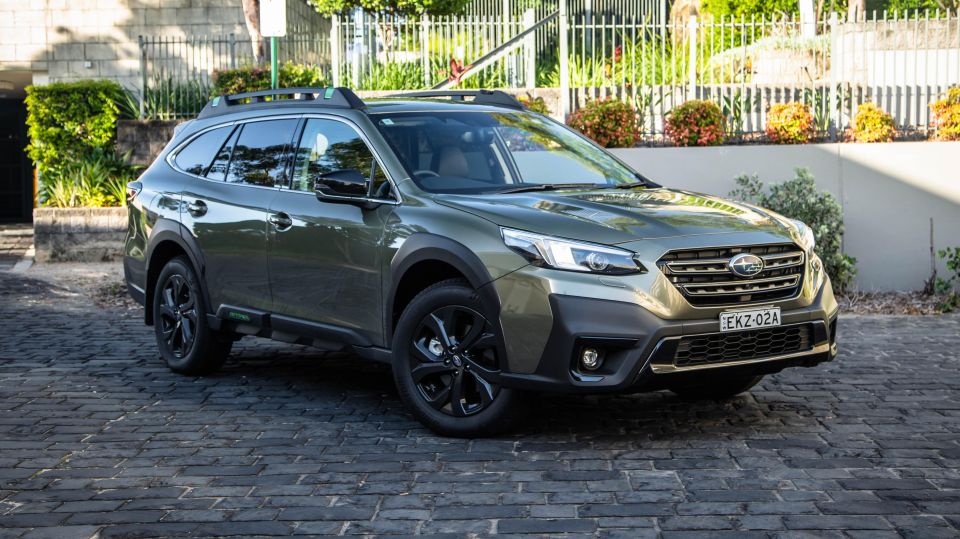
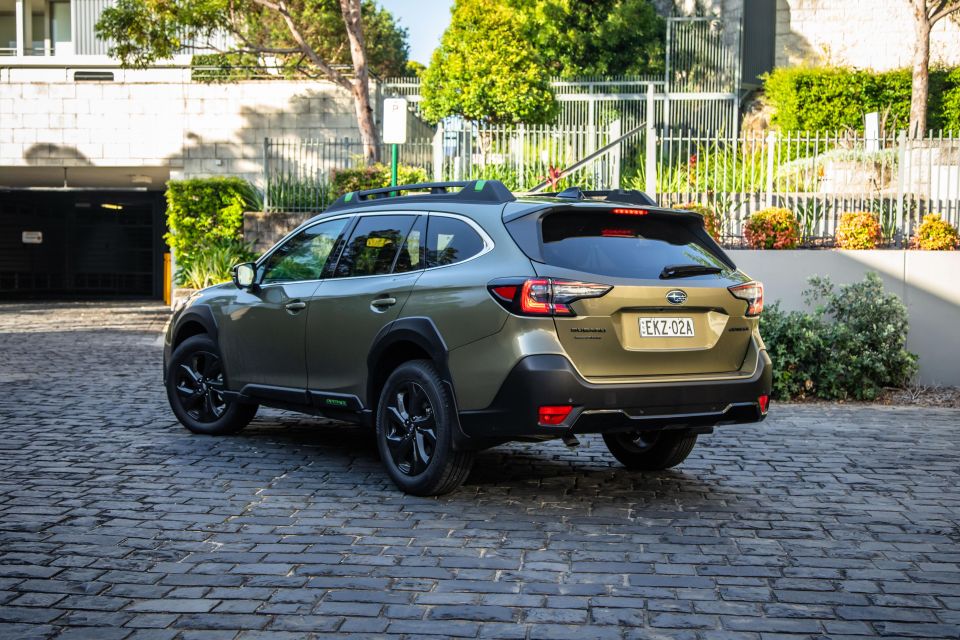

Journalist
New from
$44,490
excl. on-roads

Journalist
New from
$44,490
excl. on-roads


Journalist
New from
$44,490
excl. on-roads

Journalist
New from
$44,490
excl. on-roads
Quickly see how this car stacks up against its competition. Select any benchmark to see more details.
Where expert car reviews meet expert car buying – CarExpert gives you trusted advice, personalised service and real savings on your next new car.
New Subaru Outback, same old tricks. Even before we lift the skirt of this all-new generation, Subaru remains steadfast in its claim its jacked-up estate is an ‘SUV’. Just between you, me and the internet, it was and still remains a station wagon – no squinting required.
Or is it? There’s some logic to suggest Outback is more a sport utility vehicle by definition than a good many of the bum-dragging, urban-centric SUVs we know by colloquial labelling.
Personal viewpoints notwithstanding, I too would call Outback an SUV if I was Subaru. Why? Because it’ll attract wagon-lovers who look past the ruse anyway. And, it’s also going to attract those who must – practically, socially, psychologically – have an SUV and care little about ‘details’ large or small. Win-win.

All new? Perhaps so looking at part numbers. But from the get-go, the new Outback experience doesn’t fall very far at all from the old and familiar tree in how it looks, feels and drives, its cabin ambience, right through to the engine.
Subaru has rich providence with the locals and even casual observers are knowledgeable and often strongly opinionated before they’ve given a new spin on a storied nameplate a, erm, spin.
So much about the new steed’s form guide strongly suggests Subaru is sticking to old, familiar and certifiably safe guns with Outback, no matter how the loud calls are from the sidelines to inject the machine with something genuinely new and different – such as that American 2.4-litre turbo engine unlikely to jump the pond any time soon.
As a former Subaru devotee from a family of former Aussie devotees, perhaps its best to park preconceptions at the garage door and give the things a chance to prove itself on standalone merit.
There’s one powertrain but three variants and various differences in features and equipment. Our 2021 Subaru Outback AWD Sport tester plugs the middle ground at $44,490 before on-roads.
Sat below it is the (just) Outback, at $39,990 list, and above dwells the flagship Touring version at $47,790 list. All nine colours, including the fetching Autumn Green Metallic of our tester, are available at no extra cost.
The list of rival options is dizzying depending on whether you’re drawn to the concept of a regular wagon, an SUV, a ute-based five-door off-road specialist or perhaps a luxury estate on stilts festooned with plastic cladding.
Keeping things simple and closer to home, Outback Sport money, or thereabouts, will get you any Forester you fancy, petrol (recommended) or hybrid (less so).

Buy your new car without the stress. It's fast, simple and completely free.

Great service from Travis and team, second time I have used this business would not hesitate to recommend them to anyone
Craig C.
Purchased a Ford Ranger in Sunshine Coast, QLD
CarExpert helped Craig save thousands on his Ford Ranger, now let us save you on your next new car.
Find a dealAs outlined in our Outback Touring review, there are no options per se, though Subaru does offer a huge range of accessories, including the achingly fetching 18-inch Rugged Wheel set. So you can’t, say, option leather into the base Outback if you like that version’s grey finish rims.
Each variant gets a dedicated aesthetic and seat trim type and higher grades replace or upgrade equipment accordingly.
Outside, all Outbacks fit 18-inch wheels, self-levelling LED headlights, LED tail lights, roof rails, heated and power-folding mirrors, privacy glass, signature plastic cladding, auto wipers and a reversing camera.
Inside, all variants get analogue instrumentation, a 4.2-inch LCD driver’s screen, a leather-trimmed paddle-shifter steering wheel, dual-zone climate control with rear air vents, rear floor heater ducts, an auto dimming rear view mirror, four USB ports and dual 12-volt outlets.
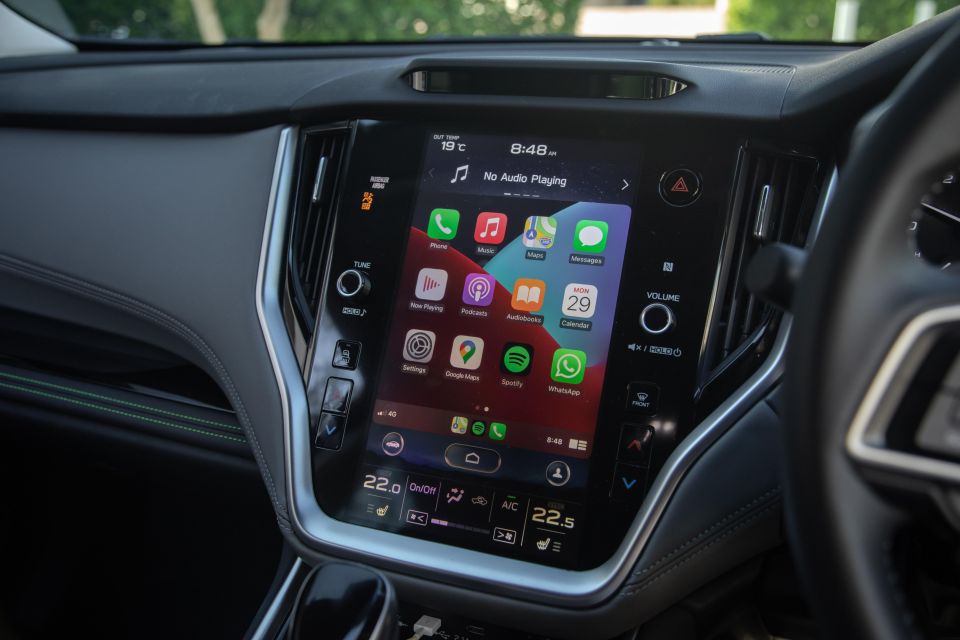
Infotainment across the range is the new, whiz-bang 11.6-inch portrait-style touchscreen system with DAB+ as well as Apple and Android smartphone mirroring.
What does the Sport add, feature-wise? The step up from base brings with it the black metallic wheels, black and green exterior highlights, a specific roof rail design (sans cross bars) and a powered tailgate.
Inside, the Sport seats feature “water repellant” faux leather trim in grey and black, while other inclusions being a premium leather wheel trim, front- and side-view cameras, proprietary sat-nav, seat heating up front and outboard in the rear, and eight (rather than four) tie-down points in the cargo area.
If the leisurewear trim is your bag, value stacks up fairly well for the Sport. An extra $3300 for the Touring brings with it nappa leather trim, an electric sunroof, a heated wheel and nine-speaker Harman Kardon audio system, which will be an enticing further splurge for some buyers. That said, all in all the Sport is otherwise well loaded with kit.
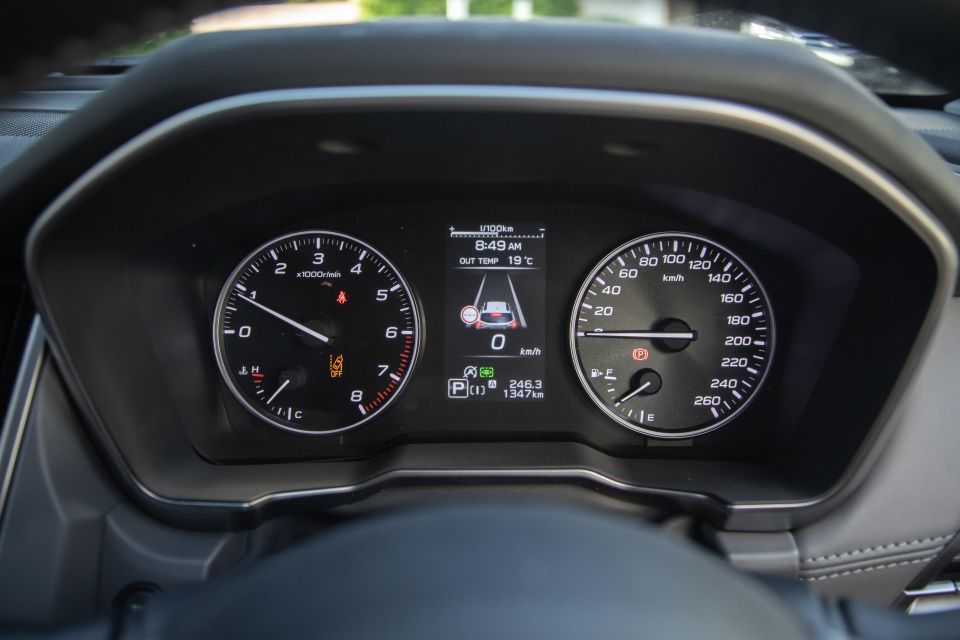
The new-generation Outback has yet to be crash tested. The old Outback achieved a five-star rating way back in 2014 – results remain on ANCAP’s website under the Liberty/Legacy report – under older testing criteria.
Fitted is the marque’s fourth-generation EyeSight suite bundling in a huge array of safety (and convenience) systems. These include all-speed autonomous emergency braking, Pre-Collision Throttle Management, lead vehicle start alert, lane departure warning, active lane keeping and lane sway warning.
There’s also a camera and rear radar-based Autonomous Emergency Steering function, speed sign recognition and bundled intelligent speed limiter.
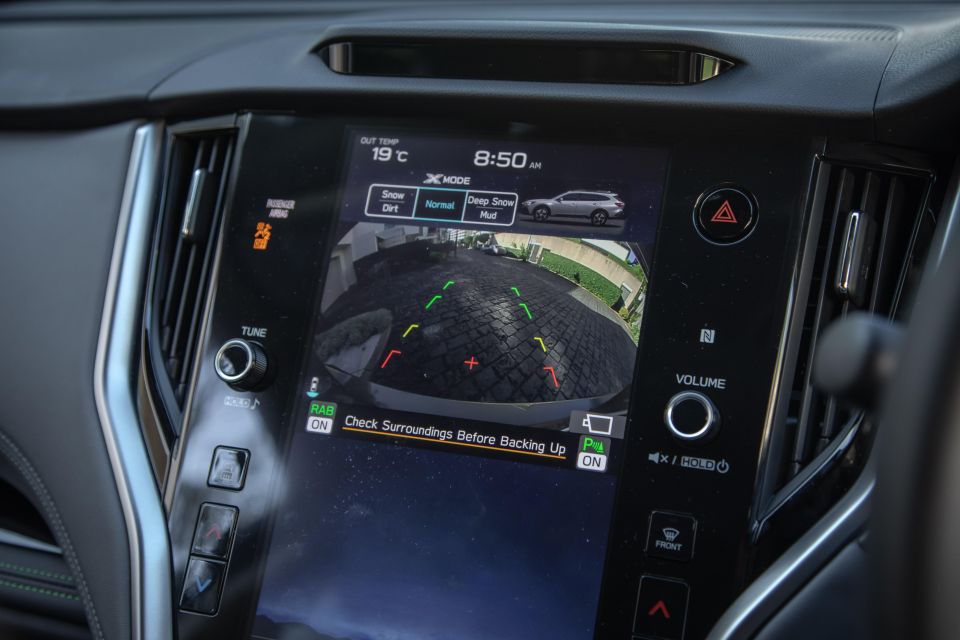
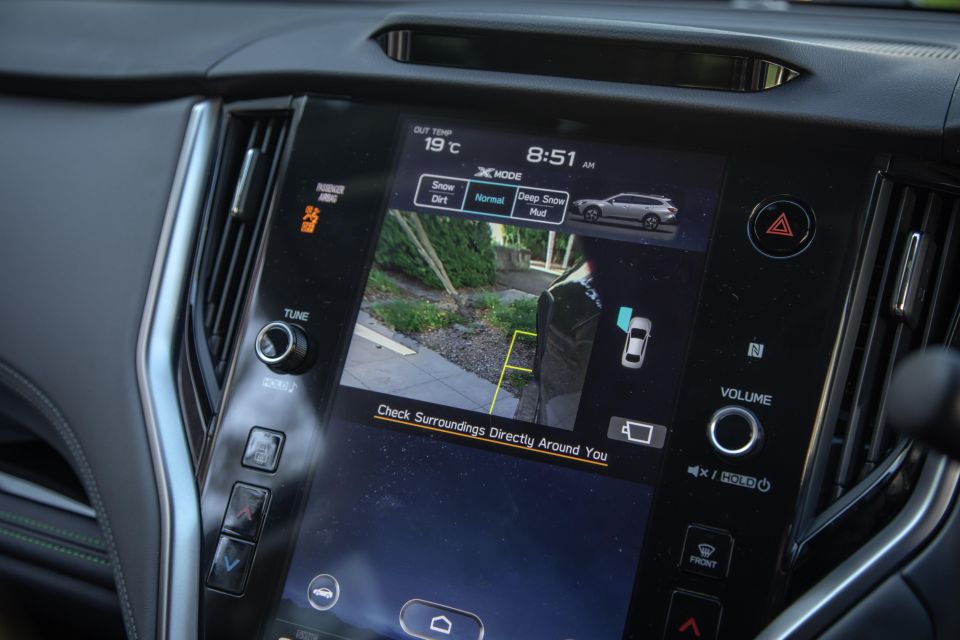
Separate, if operating in tandem, is the Vision Assist protocols that include lane change assistance, blind-spot monitoring, rear cross-traffic alert and reversing AEB.
The Sport also fits forward and kerb-side camera views, self-levelling headlights, as well as Subaru’s newly upgraded Driver Monitor System that used infrared LEDs and a camera to assess the driver’s attention – a technology that has been less than foolproof in some Subaru applications of the past.
The Outback fits eight airbags, including a nifty unit designed to prevent the front passenger from submarining underneath the seat belt.
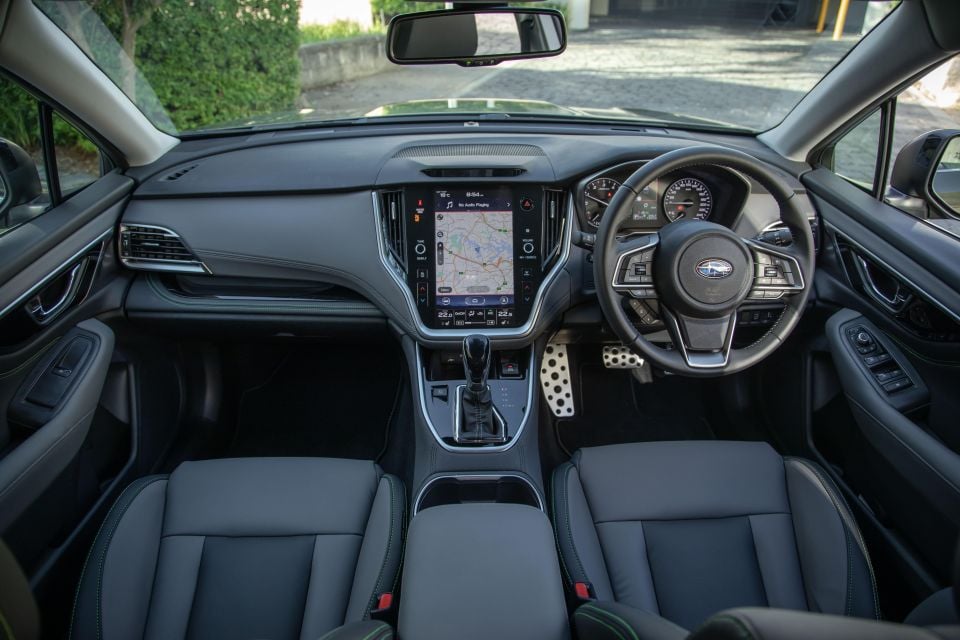
That touchscreen! It’s large enough to prompt hankerings for popcorn and Choc Tops and I lost count – well, okay, four – times other climbed in and remarked “a Tesla screen” in my week with the Sport. Somehow, I doubt that was Subaru’s intent.
The 11.6-inch vertical behemoth tries to mimic iPad-like usability, what with its main screen of semi-configurable icons and one-touch access to key features, and sort of gets away with it.
Bar the nifty sat-nav, most of the sub-pages are busy to look at and distracting to use through what proved a slow acclamation process. If it only its content was simpler and more streamlined.
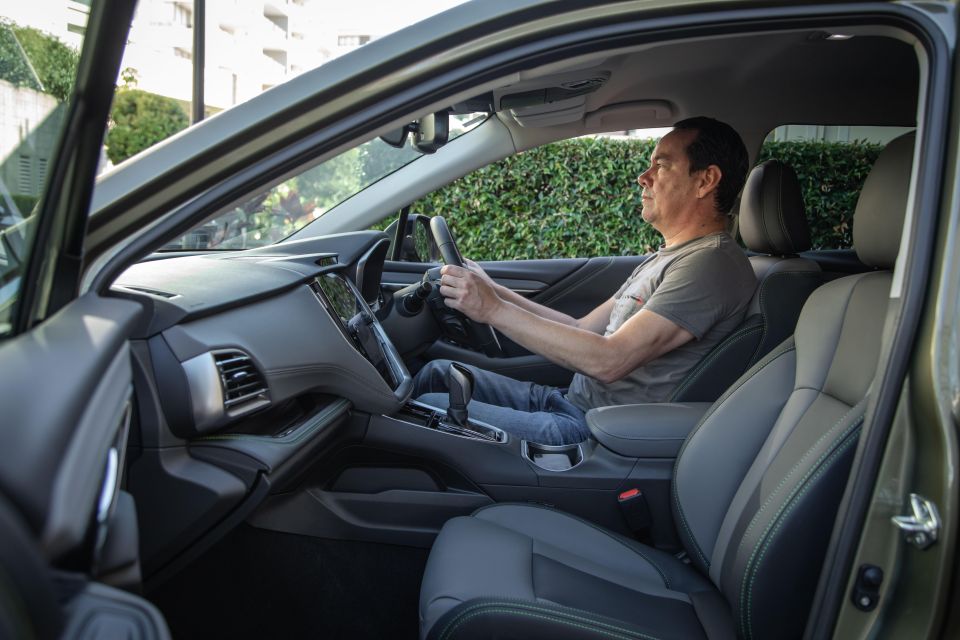
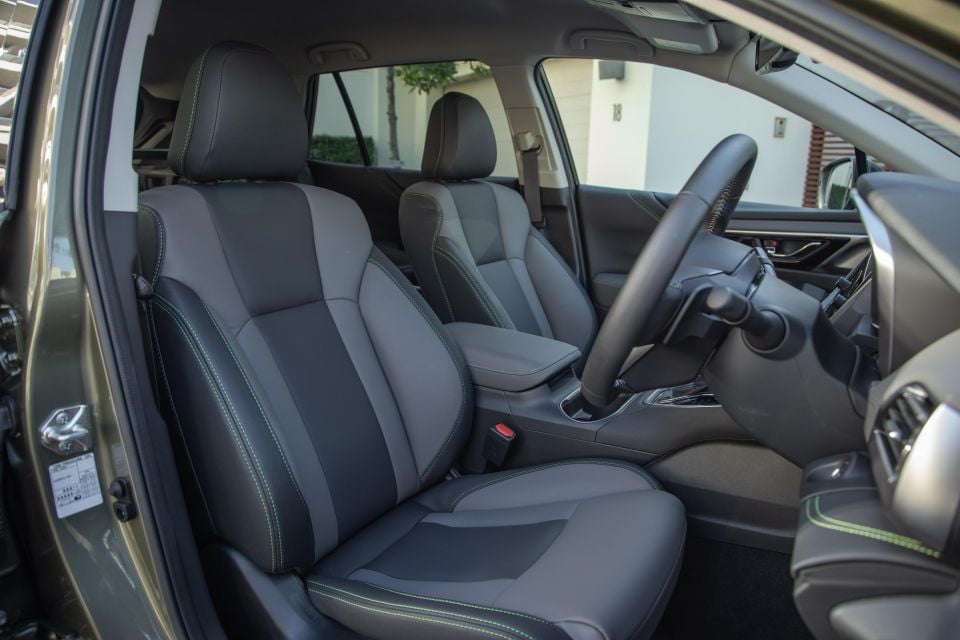
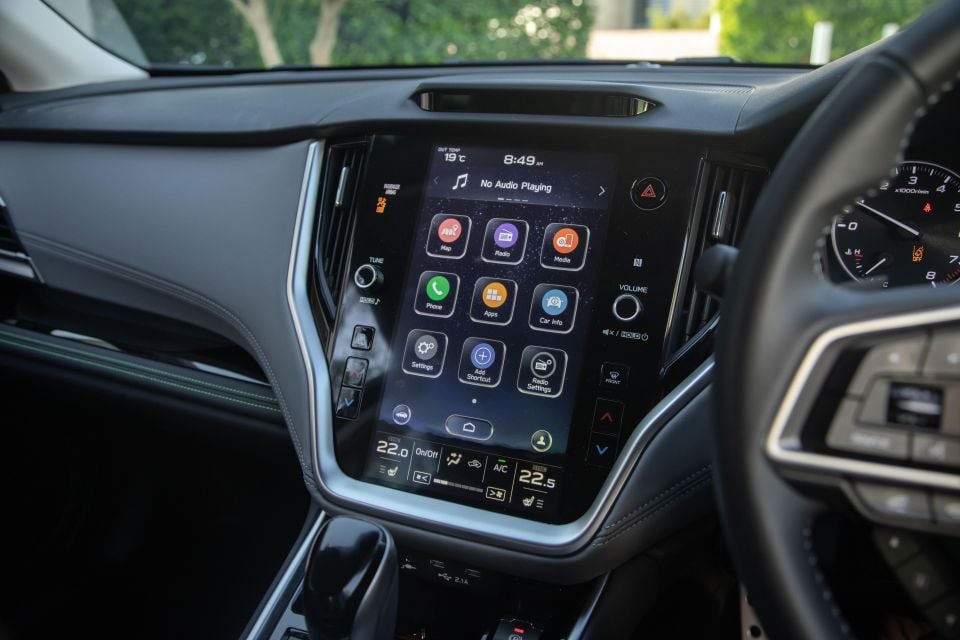
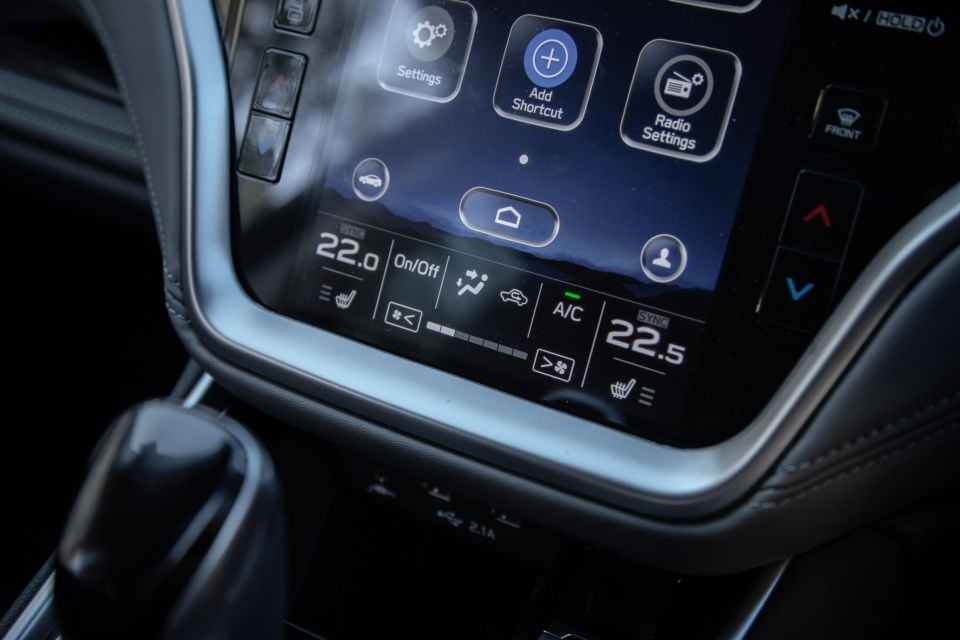
Unfortunately, Subaru integrates the lion share of the climate control inside the screen, including distracting sliders for temperature adjustment, but thankfully added short-cut buttons in the screen frame as perhaps a bit of an afterthought.
The positive is that once you get used to it, most feature adjustments are one touch away, though turning off the blaring speed camera alert ‘alarm system’ demanded lots of fumbling about and dose of luck to find tucked in some sub-menu hidden better than some raider’s lost ark.
Not perfect, then, but it’s step in the right direction compared with the triple-display clumsiness found in other Subaru model lines as well as the archaic last-gen Outback format it replaces.
Elsewhere, the new Outback cabin is more an elaborately freshened take on the old design than anything certifiably new or different. The analogue instruments and LCD driver’s screen, the button-loaded steering wheel, surface curves, the passenger’s side oddment slot, the particular blend of piano black, satin highlights and double-stitched soft surfaces have a vibe familiar to owners of recent Subaru material.
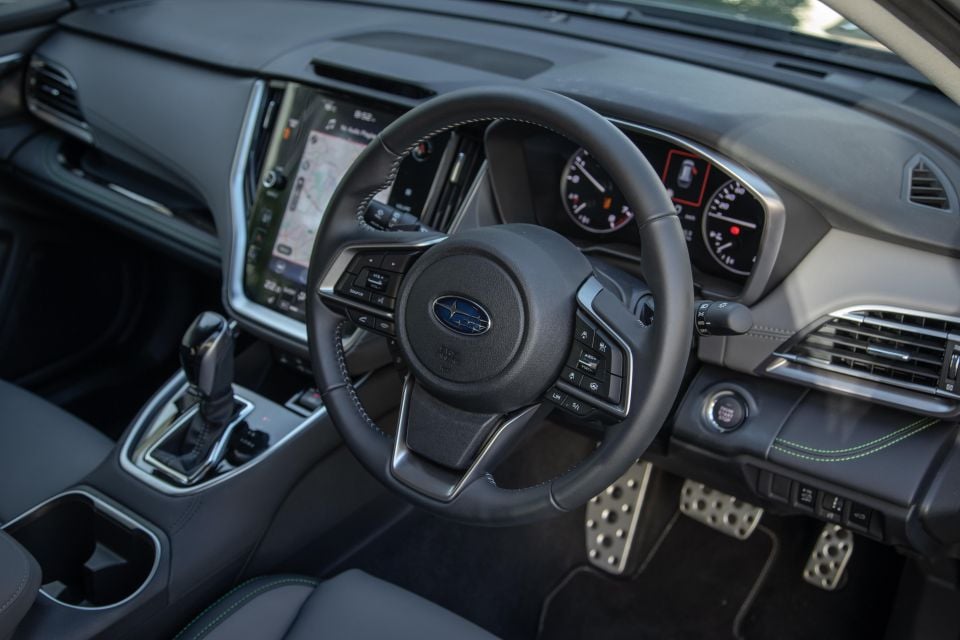
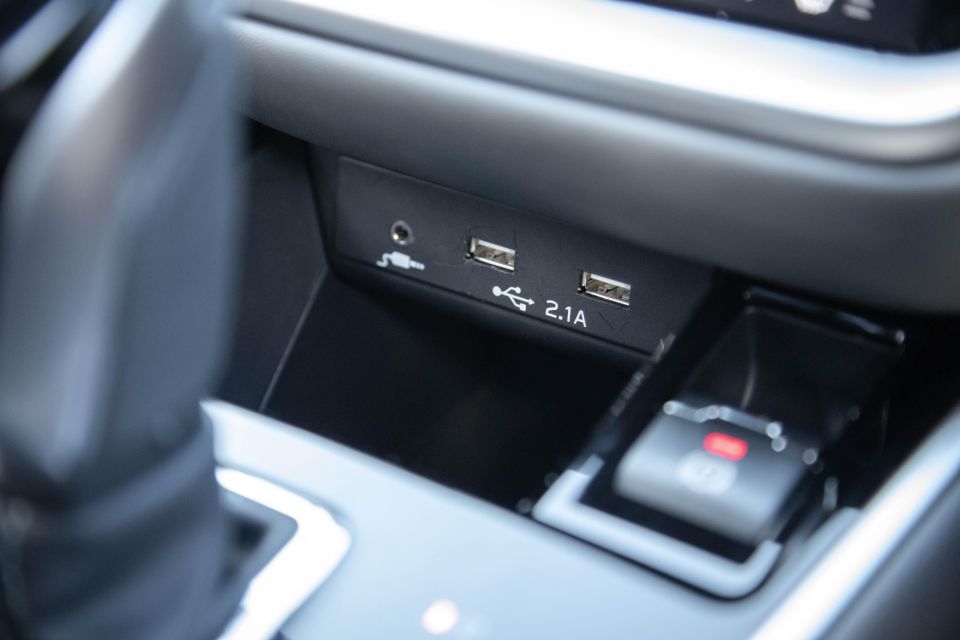
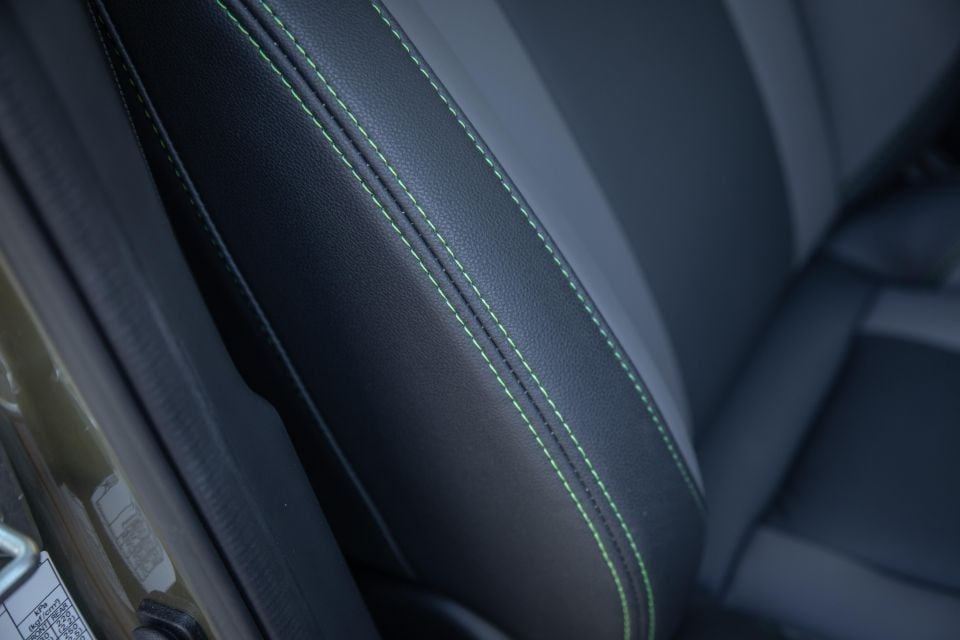
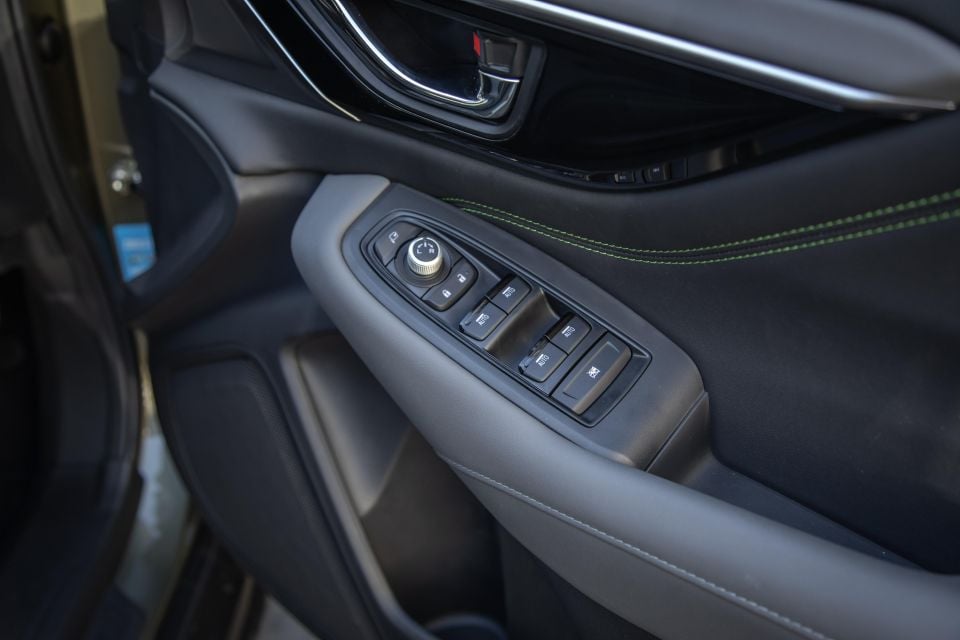
That’s no bad thing – apple, tree, etcetera – and the, visual assault apart, the rich ambience is welcoming and there’s a luxury sheen going on, even if it stops of marching into properly premium territory.
No inductive charging is a bit of a missed trick and access to the dual 2.1A USB ports is fiddly unless you put the transmission selector into Drive. Not ideal.
Sound ergonomics, too. Unlike Forester, say, taller drivers don’t have to contend with a shallow footwell by jamming the seat rearward and extending the wheel full reach, smashing rear legroom and putting the infotainment system out of reach.
The seats are excellent, with a relaxed shape and soft cushioning, its ‘water repellant’ – though not ‘waterproof’, says the disclaimer – trim impressively supple, feeling not unlike Neoprene to touch.
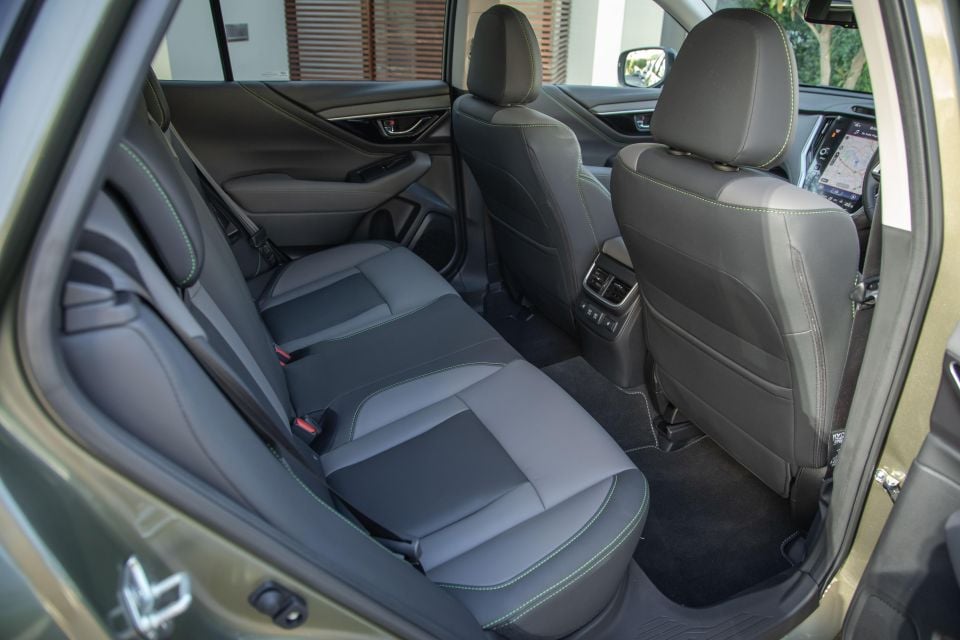
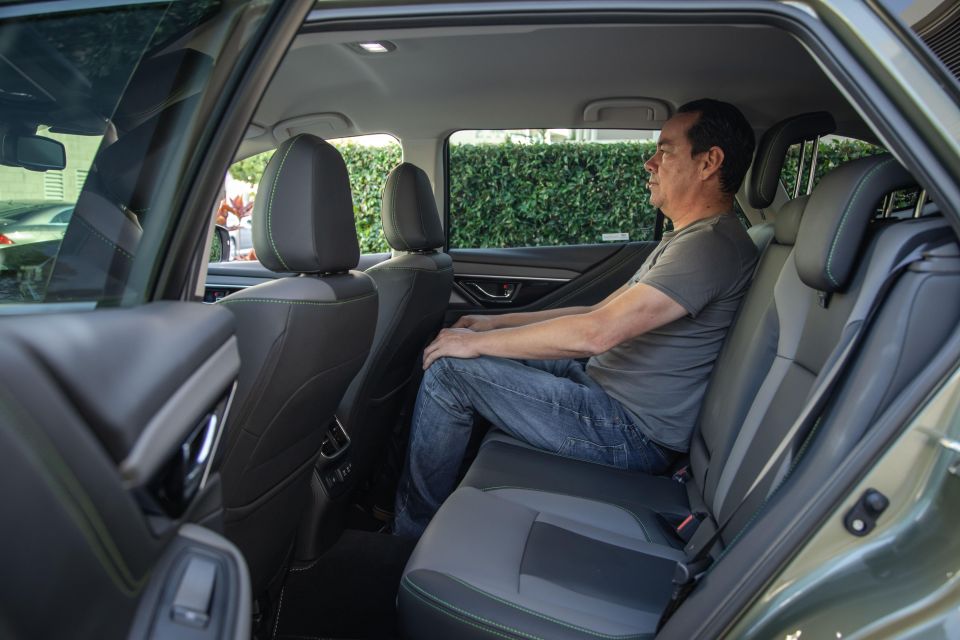
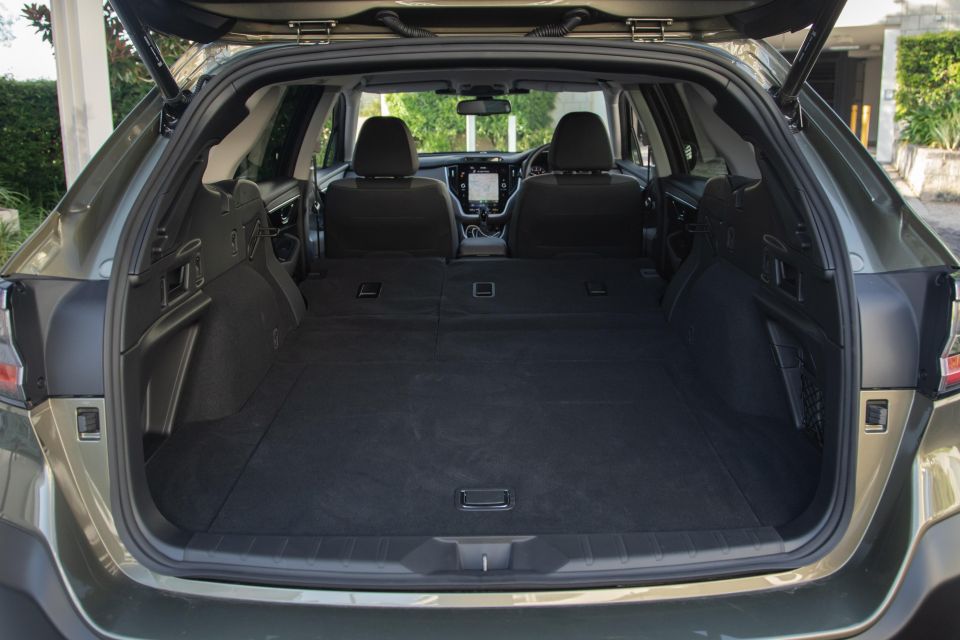

The rear 40:60-split seating is comfy and there’s a nice open ambience between the two seating rows, aided by plenty of head, knee and shoulder room in the back.
Wagon form, perhaps, but there’s certainly SUV-like roominess. One-touch rear windows, rear vents, device power and seat heating controls cater nicely to rear occupancy.
Further rearward, the boot offers 522 litres of volume with both seating rows in play with generous length and width and high set floor. Beneath sit a full-sized alloy spare wheel and tyre combination, a nice inclusion and bit of rarity these days.
Other nifty features include grocery hooks, oddment storage and remote levers to drop the rear seats to liberate a decent 1267 litres of usable space.
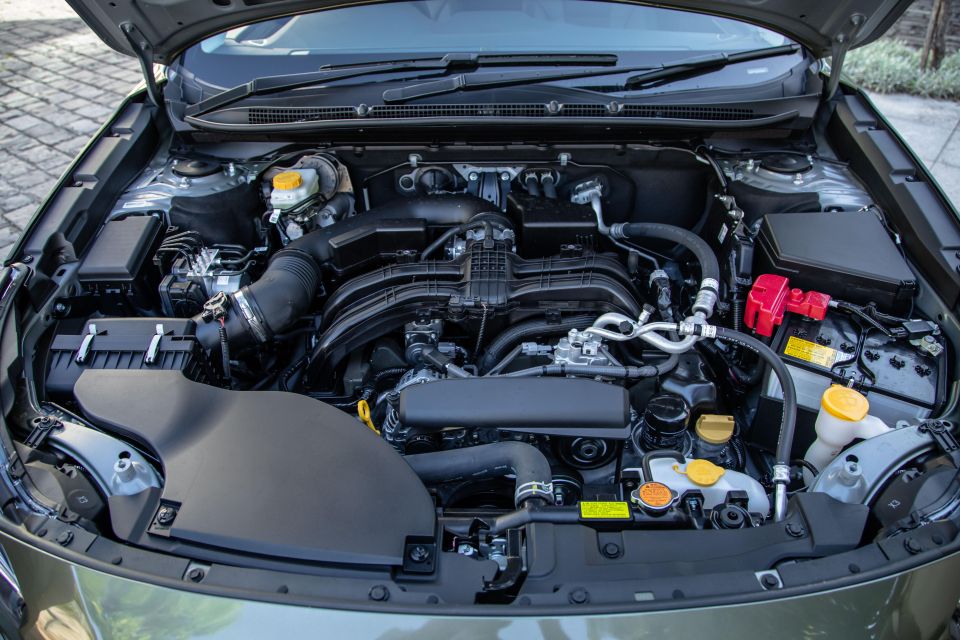
Australia gets one engine, the “90 per cent new” higher-compression, direct-injected naturally-aspirated 2.5-litre boxer four that, as mentioned above, ups power and torque nominally to what’s now 138kW at 5800rpm and 245Nm from 3400rpm, so it peaks a little earlier than old unit.
There’s no six-pot option or the made-in-America-for-America 2.4-litre turbo unit because, as we’ve reported prior, it’s not developed for right-hook in the new Subaru Global Platform underpinning our Outback that’s manufactured in Japan. So, don’t hold your breath.
The good news often overlooked is this new platform and powertrain combination affords longer servicing intervals – used to be every six months, now it’s every 12 months.

It seems like a minor benefit until the running costs and frequency of off-the-road inconvenience starts stacking up throughout ownership.
The 2.5-litre flat-four is backed by a CVT and, of course, permanent all-wheel drive. Braked towing is rated at a decent 2000kg.
In short, what the powertrain lacks in force-induced satisfaction it counters with a scope of flexibility that’s perhaps better suited for regional ownership than the range it replaces.
The Outback runs happily on crappy 91 RON unleaded and, at 7.3L/100km (claimed), there’s no change in claimed combined fuel consumption against the old 2.5-litre Outback.

For better or worse, depending on your viewpoint, the 2.5L boxer seems to be characteristically similar to the old engine that you might presume they’re identical.
It has the same buzzy 2000rpm cold start up, the familiar thrummy nature at idle and lopey rumble on the move, albeit very faint in what’s becoming quite a refined all-round proposition.
There are shades of improvement, most notably its slightly more leisurely nature that doesn’t feel quite so strained when you sink the right foot. The torque swells a little nicer and cleaner and the power curve seems a bit rounder, the improvement in refinement evident merely because the CVT seems now less inclined to pin the engine in its torquey mid-range less enthusiastically than the old format.

Where expert car reviews meet expert car buying – CarExpert gives you trusted advice, personalised service and real savings on your next new car.
Still, it’s not exactly effortless. Give it the berries and a gruff engine note still bursts from the relative serenity if you want to get a serious move along. But as we noted in our test of the Touring version, there are ample reserves of output to keep with the ebb and flow of urban traffic without the powertrain needing to break a sweat.
The electric steering is surprisingly clear and has a nice middling weight to it, perhaps some of the improvement the newer platform and some of it deft calibration. If you want an SUV-like package but can’t stand the lumbering cooperation from the helm, the Outback presents a nice amalgamation in the driving experience.
The ride quality is very good, as you’d expect it to be with the thick-sidewall 60-series Bridgestone rubber and the nominally jacked-up ride height of the fully-independent suspension system.
It’s a touch soft and floaty, though you only really notice it when hitting speed bumps well beyond reasonable pace and it absorbs impacts with aplomb and settles on pretty quickly on the other side.
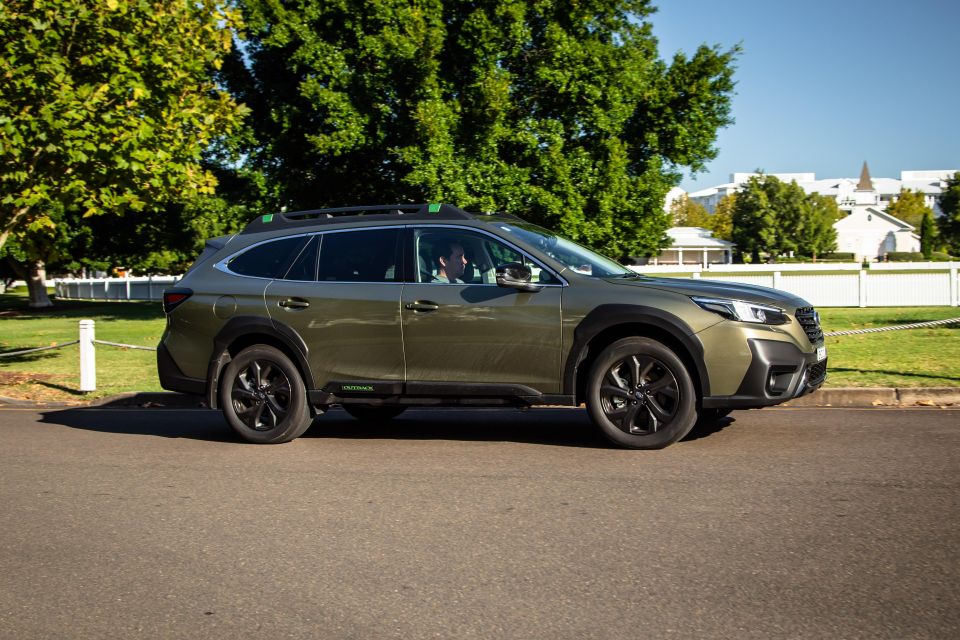
Handling is, on balance, quite cooperative. You wouldn’t go sticking Outback into a corner with too much enthusiasm but there’s a nice balance and its almost keen nature makes for a sense of surety when the roads get plenty slippery, as the Subaru demonstrated during those terribly March rains that flooded so much of Australia’s mid-eastern coast.
It’s also amply planted and stable on the open road, a quiet runner bar a bit of tyre noise across crook surfaces.
Those Bridgestone Dueler H/Ps are reasonably handy on broken surfaces, but the 213mm of ground clearance does tend to favour more ‘European style’ off-roading where you’re mostly tacking graded tracks and need traction rather than extreme wheel articulation.
In this sort of environment, the permanent all-wheel drive system Subaru has long employed works a treat, and there’s the X-Mode smarts in different traction control settings to leverage a bit more beaten track cooperation if the situation and terrain demands.
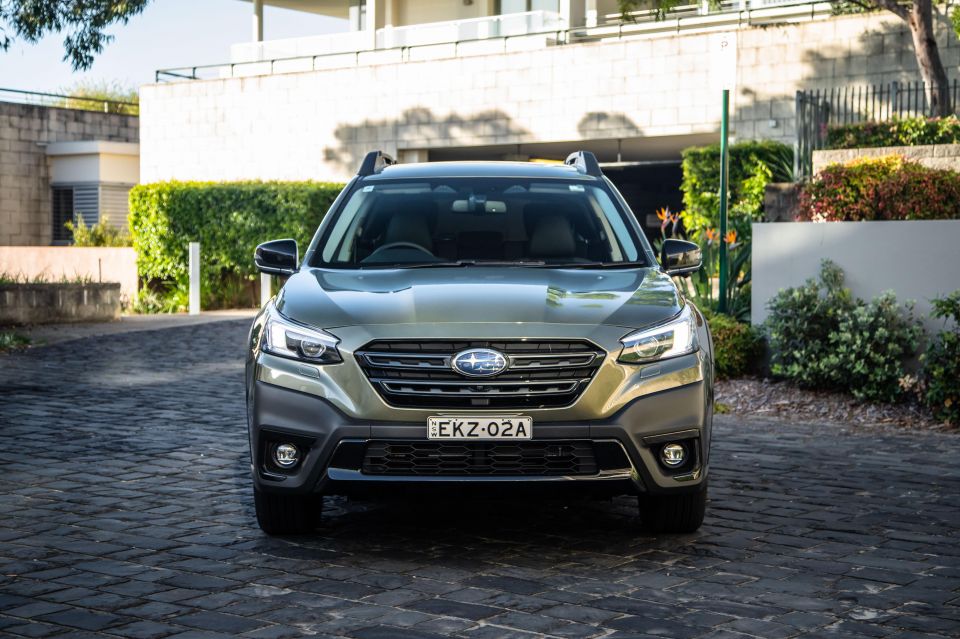
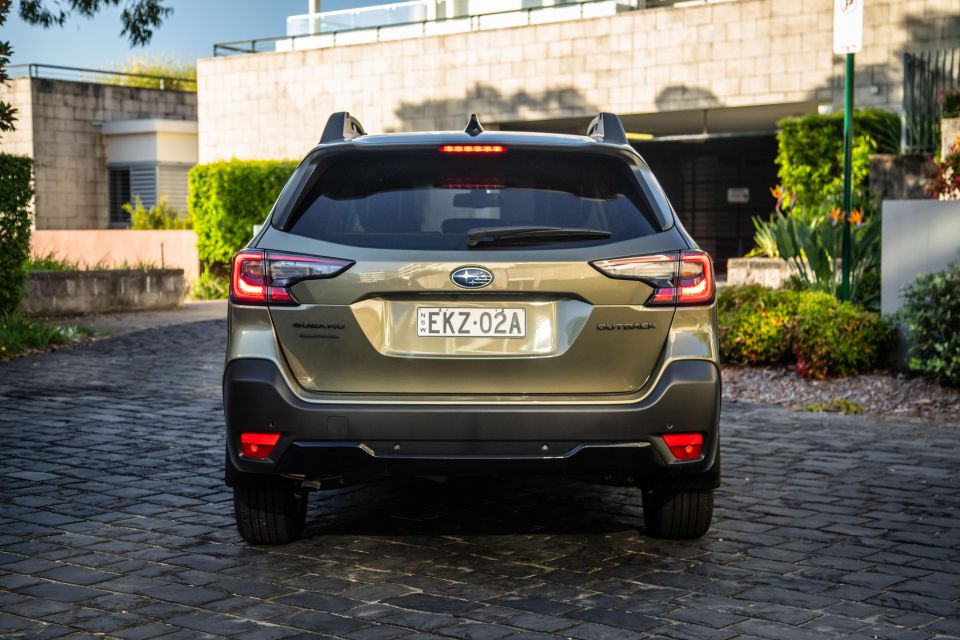
How do other electronic conveniences fare on road? They’re mostly calibrated with very conservative thresholds, including the forward collision warning system that picks up parked cars and the reversing collision system that triggers even when the Outback’s rump is aimed towards the kerb while parking. And, the speed camera alert is so loud and alarming that I switched it all off.
The self-steering operation, tied to the adaptive cruise control, tends to meander across the chosen lane in what I can only describe as a slightly drunken manner, so you tend to want to counter-steer against the system, thus rendering it fairly redundant.
Additionally, the cruise control likes to pluck engine rpm outside of the noisy peak torque band, changes in elevation tends to fluctuate road speed more than you like.
All in all, though, the Outback is a bit more dignified and comforting than the old generation, itself a bit a step up from the slightly flustered on-road manner of a Forester.
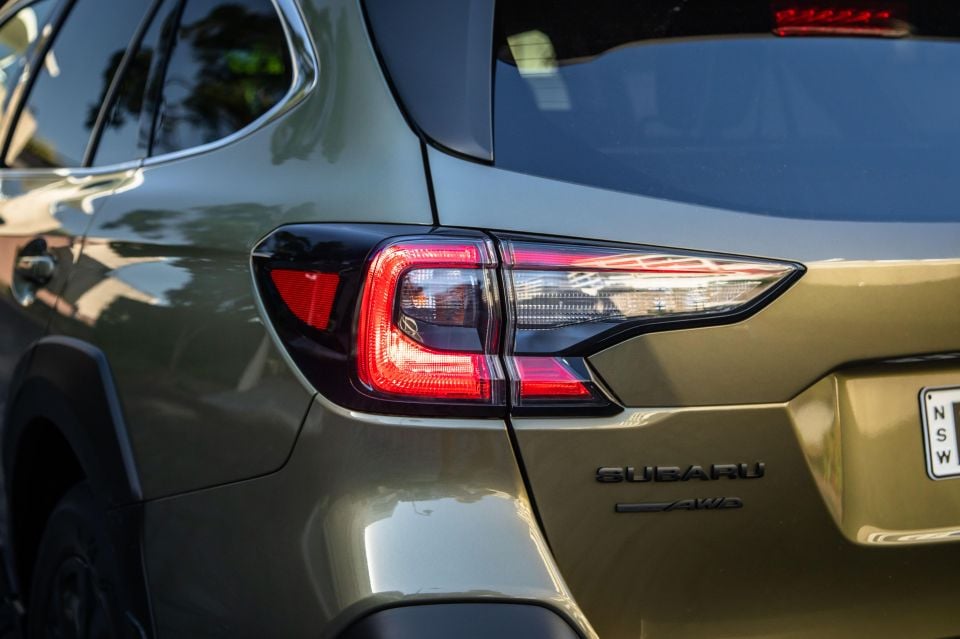
Subaru offers a decent five years of unlimited-kilometre warranty.
As mentioned above, the big improvement in ownership is a lift from the old, pricey and annoying six-month servicing intervals to the more acceptable 12-month frequency, capped at 12,500km per visit.
Pricing averages out to around $490 per visit over the first five years given the total outlay of $2450 for the period.
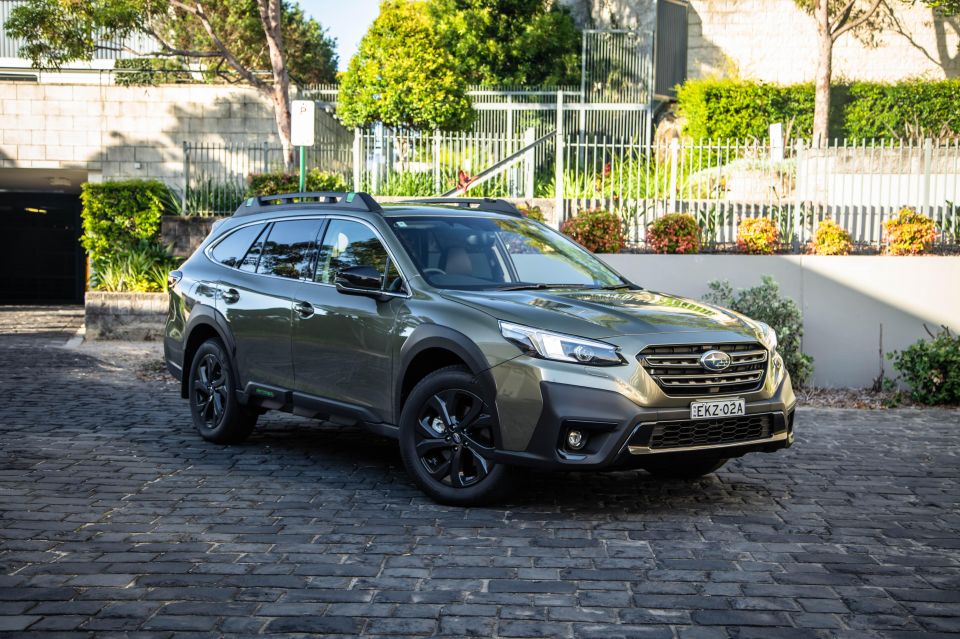
In many ways, calling the Outback an SUV is underselling what is more a Swiss (or Japanese) army knife of family-friendly flexibility.
Despite the on-stilts posturing, it really delivers more of the sort of driving experience you expect from a conventional wagon. And yet, in real-world experience, it doesn’t really lack in terms of space and practicality.
Subaru trades well on bundling in a lot of kit for your dough. The fulsome fit-out and slim options list works a treat in the value for money stakes.
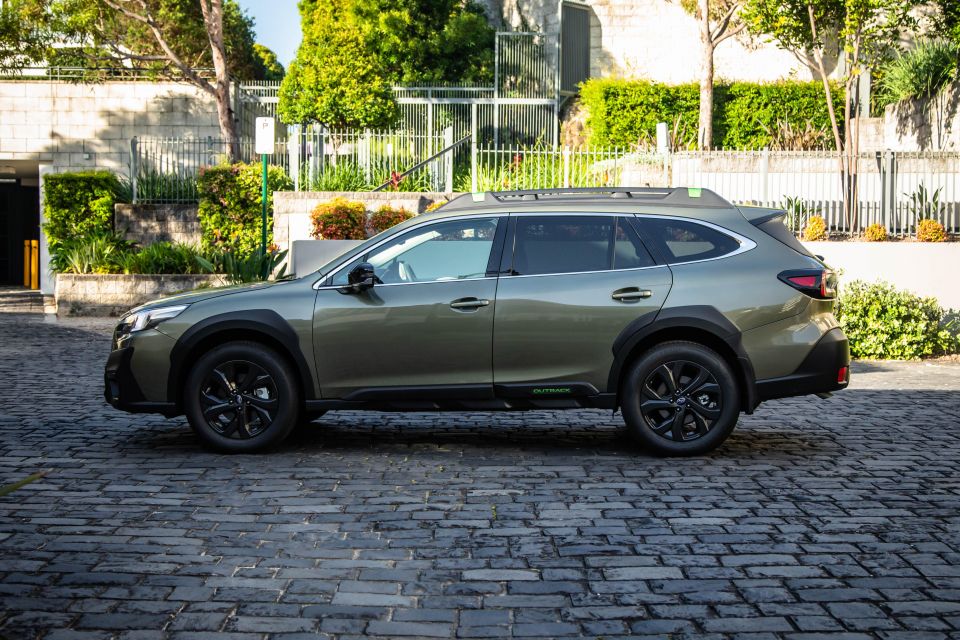
Further, the mid-spec Sport feels upmarket enough – and its seating is plush enough – that you really question whether you want to spend that $3300 step-up to the flagship Touring version.
But while impressions are that the new Outback is better than the likeable older generation, it’s different in shades and mostly in final polish.
No bad thing, but it’s perhaps less a great step forward than you might otherwise be expecting. An evolution of the species, then, rather than something to get too excited about as a major upgrade for owners of the older stuff.
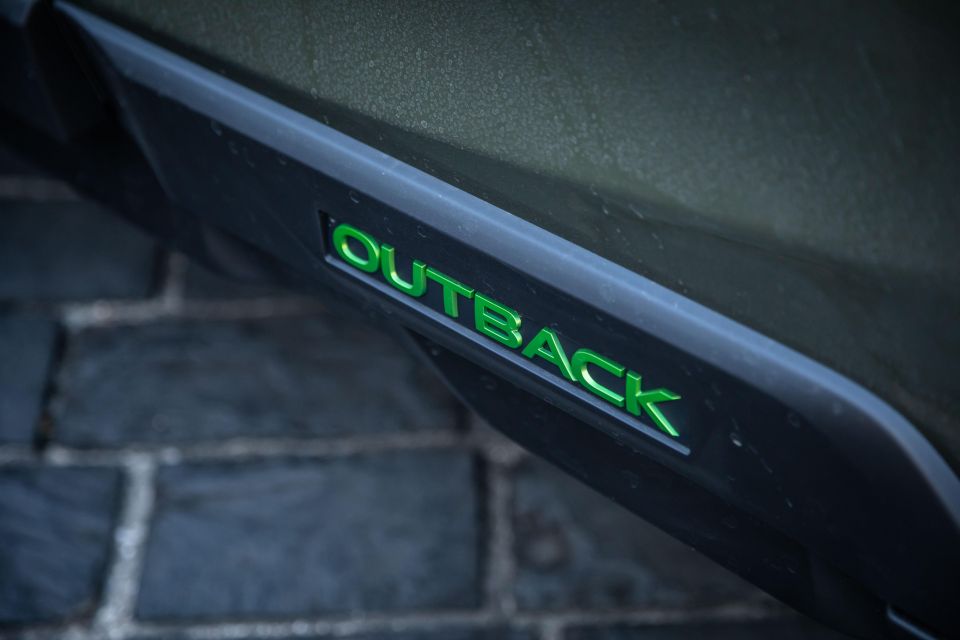
Click the images for the full gallery
Where expert car reviews meet expert car buying – CarExpert gives you trusted advice, personalised service and real savings on your next new car.


Josh Nevett
2 Days Ago


CarExpert.com.au
3 Days Ago


Damion Smy
5 Days Ago


Derek Fung
5 Days Ago


Ben Zachariah
8 Days Ago
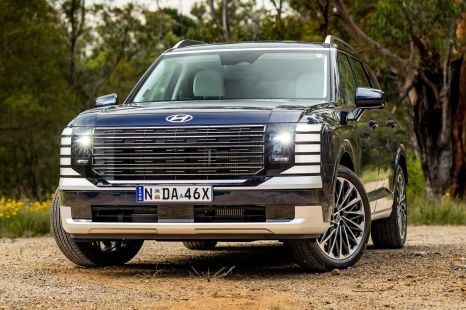

Matt Campbell
12 Days Ago